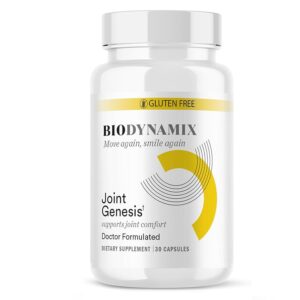Joint health is one of the cornerstones of healthy aging, mobility, and independence. Whether you’re recovering from stiffness, dealing with age-related discomfort, or simply want to stay active, a structured 30-day reboot plan can make a noticeable difference.
This guide gives you everything you need: a step-by-step 30-day joint reboot plan, a daily tracker template, and a supplement schedule designed to help you stay consistent and see real results.
Why a 30-Day Joint Reboot Works
Most people try joint supplements or exercise routines without structure—and then wonder why results are slow or inconsistent. A reboot plan works because it:
- Creates a daily habit loop for supplements, hydration, and movement.
- Tracks progress so you can see small wins week by week.
- Combines science-backed supplements, nutrition, and low-impact exercise for comprehensive results.
- Builds consistency, which is the real key to reducing stiffness and supporting mobility.
By following a clear 30-day framework, you’ll not only feel better now—you’ll also set the foundation for long-term joint health.
Core Components of the 30-Day Reboot
- Supplements – To provide targeted nutrients for cartilage, synovial fluid, and inflammation.
- Exercise – Gentle, low-impact movement to lubricate joints and strengthen supporting muscles.
- Nutrition – Anti-inflammatory foods that fuel repair and resilience.
- Hydration – Essential for joint lubrication and tissue health.
- Tracking & Reflection – To measure improvements in pain, stiffness, and mobility.
Week-by-Week Breakdown
Week 1: Foundation Phase
- Goal: Build habits and start daily supplement use.
- Supplements: Begin with glucosamine sulfate (1,500 mg), chondroitin (800–1,200 mg), or a complete formula like Joint Genesis®.
- Exercise: 10–15 minutes of walking, yoga, or swimming daily.
- Nutrition: Add fatty fish (salmon, sardines) and leafy greens to reduce inflammation.
- Tracking: Rate morning stiffness (1–10 scale) and note daily activity levels.
Week 2: Consistency Phase
- Goal: Stay on schedule, notice early improvements.
- Supplements: Continue baseline formula; add turmeric (curcumin with BioPerine®) for anti-inflammatory support.
- Exercise: Increase to 20 minutes/day, include light strength training.
- Nutrition: Incorporate nuts, seeds, and olive oil for omega-3 and healthy fats.
- Tracking: Add evening notes on joint discomfort levels.
Week 3: Strength & Mobility Phase
- Goal: Improve flexibility and reduce daily stiffness.
- Supplements: Maintain core formula; consider adding collagen peptides (5–10 g daily).
- Exercise: Gentle stretching, resistance bands, or Pilates to build muscle support.
- Nutrition: Limit processed sugar; add berries and colorful vegetables.
- Tracking: Record range of motion improvements (e.g., easier squatting, less stiffness after sitting).
Week 4: Optimization Phase
- Goal: Notice significant differences in comfort and mobility.
- Supplements: Continue daily formula; add omega-3 fatty acids if not already included.
- Exercise: 30 minutes/day, mixing cardio and strengthening.
- Nutrition: Focus on balanced meals with lean protein, vegetables, and anti-inflammatory spices like ginger.
- Tracking: Reflect on overall improvements compared to Day 1.
By the end of 30 days, most people experience less stiffness, greater flexibility, and better energy for daily tasks.
Daily Supplement Schedule
A structured schedule keeps absorption high and side effects low.
- Morning (with breakfast): Glucosamine + chondroitin or your chosen joint formula, omega-3, turmeric.
- Midday (optional): Collagen peptides (can be mixed into smoothies or coffee).
- Evening (with dinner): MSM or additional hyaluronic acid supplement, if included.
- Hydration tip: Drink 6–8 glasses of water throughout the day to maximize hyaluronic acid benefits.
30-Day Joint Tracker Template
Use this simple template (printable or digital) to track your progress:
| Day | Morning Stiffness (1–10) | Pain During Activity (1–10) | Exercise Done | Notes |
|---|---|---|---|---|
| 1 | 7 | 6 | Walk 10 min | Hard to get up from chair |
| 7 | 6 | 5 | Walk + stretch | Easier mornings |
| 14 | 5 | 4 | Yoga 20 min | Knees less sore |
| 21 | 4 | 3 | Walk 25 min | More energy |
| 30 | 3 | 2 | Walk 30 min | Can bend easily |
Tracking ensures you see progress—even if it feels slow day to day.
Tips for Success
- Set reminders on your phone to take supplements daily.
- Pair habits: Take your joint capsule with morning coffee or after brushing teeth.
- Celebrate milestones: Each week completed is a win.
- Stay realistic: Supplements improve comfort and mobility, but they work best when combined with lifestyle changes.
Who Benefits Most from a 30-Day Joint Reboot?
- Adults over 40 noticing stiffness or reduced flexibility.
- Seniors who want to maintain independence and daily activity.
- Athletes or active individuals recovering from overuse.
- Anyone looking to start a consistent joint health routine.
Final Thoughts
A 30-Day Joint Reboot isn’t about overnight miracles. It’s about building daily habits that protect your joints, reduce discomfort, and restore confidence in your mobility.
By combining the right supplements, consistent exercise, anti-inflammatory nutrition, and daily tracking, you’ll finish the month with stronger, more flexible joints—and a sustainable plan to keep them healthy for years to come.
Your joints don’t just need care today; they need a long-term routine. The next 30 days can be your reset button.

